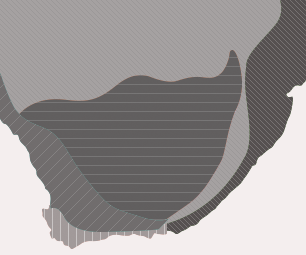Crassula smithii
Crassula smithii Van Jaarsv., D.Styles & G.McDonald
Family: Crassulaceae
Common names: Noodsberg cliff-crassula (Eng.), Noodsbergkransplakkie (Afr.)
Introduction
Crassula smithii is a rare, sparingly branched succulent, with yellowish-green leaves in a dense rosette and a rounded inflorescence of many small, star-shaped red fowers in late summer. Plants are cluster-forming, becoming cliff-huggers. They grow wild on the cliffs of the Noodsberg in KwaZulu-Natal and are easily grown in pots.

Fig. 1. Crassula smithii flowering in habitat, Noodsberg cliffs, KwaZulu-Natal.
Description
Description
The plants are perennials, forming compact, rosulate, basal clusters, when in flower up to 250 mm tall, and 200 mm in diameter. The roots are fibrous. The stems erect to decumbent, succulent, glabrous, terete, up to 8 mm in diameter, yellowish green at first, becoming reddish brown with age. The leaves are sessile, firm, distinctly succulent, linear-triangular, 40–160 × 8–12 mm; adaxial surface flat to slightly channelled, lower surface rounded, yellowish to reddish green. The leaf margin is entire with a pointed leaf tip (apex acute), and bearing a short point (mucro). The inflorescence is a terminal, round-topped thyrse with many pedicellate, 5-merous flowers in 1–many dichasia; basal part of inflorescence without hairs (glabrous), the upper parts with scattered, recurved, scabrid hairs; bracts triangular-subulate, becoming smaller distally; basal bracts 10 × 4 mm, distal bracts 4 × 1.5 mm; pedicels 7–25 mm long. The sepals are triangular, 4 × 1.5 mm, surface subglabrous, with scattered recurved translucent scabrid hairs, with distinct marginal cilia; apex acute. The petals triangular, 5 × 1.8 mm, spreading, slightly recurved at tip; apex reddish with distinct subulate dorsal appendage, 0.5 mm long. The stamens 5 × 0.8 mm, tapering towards apex; anthers 0.8 × 0.5 mm, brown; pollen yellow. The fruits are carpels tapering into subulate styles. Flowering time is in summer and autumn (January–March).

Fig. 2. An illustration of Crassula smithii by Vicki Thomas, from a plant grown at Kirstenbosch National Botanical Garden, in the Succulent Collection.
Conservation Status
Status
Assessed as Rare by the Red List of South African Plants. Although Crassula smithii is not common locally, it is well protected by its inaccessible cliff habitat.

Fig. 3. A close-up of a Crassula smithii plant in flower, in habitat, on a ledge of the Noodsberg cliffs.
Distribution and habitat
Distribution description
Crassula smithii is known only from the Noodsberg, northwest of Durban, KwaZulu-Natal. It grows on exposed quarzitic sandstone cliffs of the Natal Group (Cape Supergroup) at altitudes of up to about 1 300 m. Plants grow in shallow soil on sunny rock ledges. Temperatures are moderate in summer and mild to lower in winter. Average daily maximum temperature is about 24°C and daily minimum about 12°C. Rainfall is mainly in summer in the form of thunder showers, ranging from 700–800 mm per annum. The associated cliff vegetation includes the KwaZulu-Natal Sandstone Sourveld of the Savanna Biome. Associated succulent plants in its habitat recorded by David Styles include Aeollanthus parvifolius, Aloe arborescens, Crassula perfoliata var. heterotricha, Cyanotis sp., Delosperma sp. (white flowers), Plectranthus purpuratus subsp. purpuratus and Senecio rhyncholaenus.

Fig. 4. Noodsberg cliffs, KwaZulu-Natal, habitat of Crassula smithii.
Derivation of name and historical aspects
History
Crassula smithii was named after Gideon Smith (1959–), former Chief Director of Biosystematics Research and Biodiversity Collections at the South African National Biodiversity Institute, who not only discovered this species but made a great contribution to our knowledge of succulent plants in South Africa and abroad. It was named by David Styles, G. McDonald and the author in Aloe magazine in 2008. For the full story of its discovery and identification, see Smith, Crouch and Condy's 2013 article in Flowering Plants of Africa.
Crassula smithii belongs to Section Rosulares, which Adrian Haworth named in 1821, in which Toelken acknowledges 25 species to which C. cremnophila, C. foveata and C. smithii were added, bringing the total to 28 species. Of these Crassula smithii is closest to Crassula alba (usually growing on non-cliff terrain) but differs by its subulate (slender and tapering to a point), very succulent leaves. The leaf margin in C. smithii is not ciliate, there are fewer bracts on the inflorescence and the peduncle is without hairs (glabrous). The calyx lobes are smaller (half the length of those of C. alba). The largest species in this section is C. acinaciformis grows up to 1.3 m when in flower.

Fig. 5. A group of young Crassula smithii plants on a sandstone cliff ledge on the Noodsberg.
Ecology
Ecology
The plants are cluster-forming, conspicuous and not camouflaged, and unarmed. The aloe-like leaves in a rosette are well adapted to the undisturbed cliff face. The leaves grow ascending-spreading to erect, compact, in a basal rosette. The compact, rosulate nature and subulate form can be viewed as an adaptation to the dry conditions on the cliff face. The leaf surface (epidermis) is green to yellowish green, becoming reddish. The reddish colour under dry conditions reduces penetration of light, an adaptation resulting from the well-drained habitat. The soft texture and fragile nature reflects the sheltered, undisturbed cliff face. The plants are relatively slow-growing, long-lived perennials.
The plants flower in late summer and autumn (March–April), and is pollinated by insects. The fruits (follicles) are dehiscent, with seeds spontaneously released and dispersed by wind. The seeds are minute and ideal for establishment in crevices. Seeds released in autumn or winter. The plant increases vegetatively, forming clusters and filling up crevices.

Fig. 6. A group of Crassula smithii plants on a sandstone cliff ledge on the Noodsberg.
Uses
Use
It is not known whether Crassula smithii plants are used medicinally. Although Crassula smithii is not well-known in cultivation, it is fairly easily grown and makes a beautiful pot plant.
Growing Crassula smithii
Grow
Best for moist bushveld gardens, grown in rockeries, on embankments or as a pot plant. Outside its native habitat, it is best grown under controlled conditions in a greenhouse. Easily cultivated and prefers full sun but will take dappled shade.
Grow in soil that is sandy, slightly acidic and well-drained. Feed with ample compost or a liquid organic fertiliser. Water well, but allow plants to dry out for some time before watering again. The stored moisture in their leaves and stems allow succulents to survive when no soil moisture is present.
Propagate from division, cuttings or seed. Best propagated by division or removing offsets, or from leaf cuttings taken in spring or autumn. Plant rosettes in a sandy soil. Leaves can be cut near the base and allowed to callus on a shady window sill. Best time is in spring and summer. Seed is fine and can be sown in a sandy mixture in autumn, and covered with a very thin layer of gravel. Keep moist. Remove seedlings as soon they are large enough to handle.
The roots sometimes can be affected by mealybug and treat accordingly.
References
- Christenhusz, M.J.M., Fay, M.F. & Chase, M.W. 2017. Plants of the World, an illustrated Encyclopedia of vascular plants. Kew Publishing, Royal Botanic Gardens, Kew.
- Clarke, H. & Charters, M. 2016. The illustrated dictionary of southern African plant names. Flora & Fauna Publications Trust, Jacana, Johannesburg.
- Eggli, U. (ed.) 2003. Illustrated handbook of succulent plants: Crassulaceae. Springer, Berlin.
- Mucina, L. & Rutherford, M.C. (eds) 2006. The vegetation of South Africa, Lesotho and Swaziland. Strelitzia 19. South African National Biodiversity Institute, Pretoria.
- Raimondo, D., Von Staden, L., Foden, W., Victor, J.E., Helme, N.A., Turner, R.C., Kamundi, D.A. & Manyama, P.A. (eds) 2009. Red list of South African plants. Strelitzia 25. South African National Biodiversity Institute, Pretoria.
- Rowley, G. 2003. Crassula: a growers guide. Cactus & Co. Vista, California.
- Smith, G.F., Crouch, N.R. & Condy, G. 2013. Crassula smithii. Flowering Plants of Africa 63: 38–43.
- Toelken, H.R. 1985. Crassulaceae. Flora of Southern Africa 14: 1–229.
- Van Jaarsveld, E.J., Styles, D.G.A. & MacDonald, G.J. 2008. Crassula smithii, a new cliff-dwelling species from Noodsberg, KwaZulu-Natal, South Africa. Aloe 45(4): 90–92.
Credits
Ernst van Jaarsveld
Kirstenbosch National Botanical Garden (Retired)
Babylonstoren Farm (Current)
Extraordinary senior lecturer and researcher,
Department of Biodiversity and Conservation, University of the Western Cape
April 2025
Acknowledgments: the author thanks David Styles for the photos and Vicki Thomas for preparing the illustration.
Plant Attributes:
Plant Type: Succulent
SA Distribution: KwaZulu-Natal
Soil type: Sandy, Loam
Flowering season: Late Summer, Autumn
PH: Acid
Flower colour: Red, White, Pink
Aspect: Full Sun, Morning Sun (Semi Shade), Afternoon Sun (Semi Shade)
Gardening skill: Average
Special Features:
Horticultural zones








Rate this article
Article well written and informative
Rate this plant
Is this an interesting plant?
Login to add your Comment
Back to topNot registered yet? Click here to register.